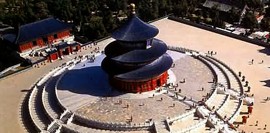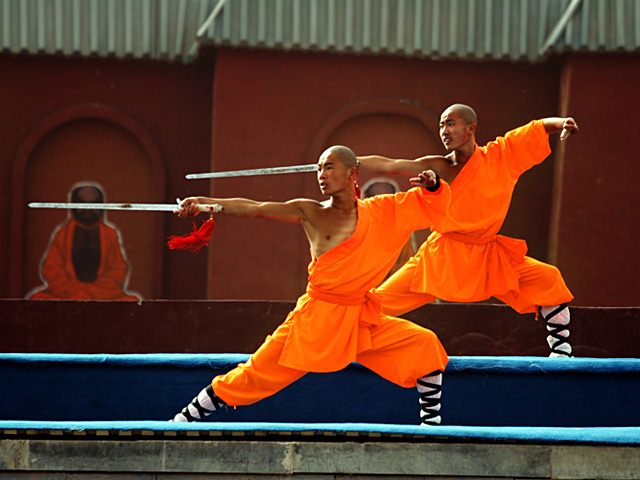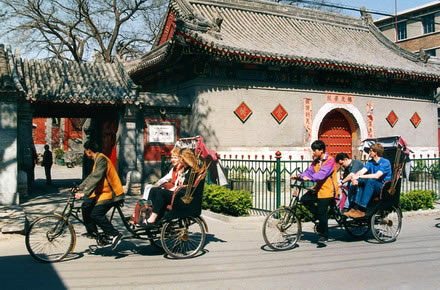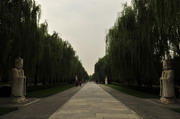
Sacred Road
This road was known as shendao, meaning "the way of the spirit." The body of the dead was carried over the route at funeral ceremony. It is 7 kilometres long, from the Memorial Arch to the gate of the main tomb.
Memorial Arch
Built of white marble, was erected in 1540. It is 12 metres high and 31 metres wide, and has 5 arches supported by 6 pillars with beautiful bas-relief carvings of lions, dragons and lotus flowers. Double lintels link the six pillars. The roofing is made of round marble tiles, with upturned corners. "The way of the spirit" used to pass beneath the Memorial Arch.
Big Red Gate
The Big Red Gate was built in 1426. It used to have three huge wooden doors. The central opening was used by the dead emperor alone, and living ministers and imperial family members had to use one of the side openings when they came to pay homage to the deceased emperors.
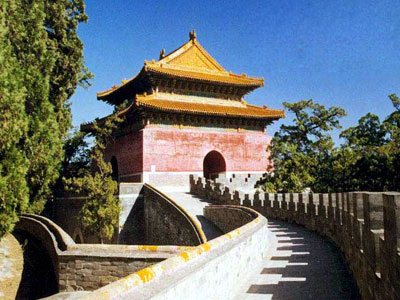
Tablet House
About 500 yards (A yard is equal to 0.914 metre.) from the Big Red Gate stands the Tablet House built in 1435. A marble column, known as huabiao, stands at each corner of the Tablet House. A huge tablet, 7 metres high, stands in the middle of the house on the back of a tortoise. The front side bears an inscription by the fourth Ming emperor. On the reverse side is an inscription carved during Qing Emperor Qianlong's reign. It described the reconstruction of the Ming Tombs in 1785 and commented on the rules and styles of the Ming Tombs.
Stone animals and Statues
Stone animals and statues are found at the entrance to imperial tombs from the Han Dynasty onwards, but none of the group is as famous as that of the Ming Tombs.
The avenue starts with two columns, called wangzhu in Chinese, one on each side. They are hexagonal, carved with a cloud design, and the top is shaped like a round cylinder. The animals are lions, xiezhi, camels, elephants, qilin and horses, one kneeling and the other standing, twelve on each side and twenty-four in all. Xiezhi was a mythical beast or the feline family, said to be able to distinguish right and wrong. Qilin was a sort of imaginary animal with a scaly body, a cow's tail, deer's hooves and horns on its head.
With "the way of the spirit" turning slightly, the statues appear: two military officers wearing sabres, two civilian officials and two ministers of merit. Six statues on each side and twelve in all.
These animals and statues all date from the 15th century. It is interesting to compare them with those at the tomb of the first Ming emperor in Nanjing, which are scarcely any older and yet much less fine.
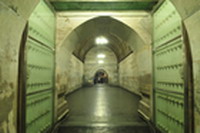
Underground Palace of Dingling
The Underground Palace of Dingling amidst pines and cypresses is the tomb of Emperor Wanli, the 13th Ming Emperor. He was born in 1563, and was chosen and named crown prince when he was six years old. He ascended the throne at the age of 10 and ruled for 48 years until he died in 1620.
Dingling is the only one of the Ming Tombs excavated so far. Excavation work took more than two years from 1956 to 1958. You may find the following background information interesting.
Emperor Wanli had two wives. The first wife Empress Xiaoduan died only a few months before his death. The second wife Empress Xiaojing died in 1612, eight years before and was buried in a nearby tomb reserved for imperial concubines. The first wife had no son while the second wife had one. He succeeded Emperor Wanli and died 29 days after his succession. He left the throne to his son. As Xiaojing was the second wife, she was not entitled to the privilege of sharing the Emperor's tomb. When her grandson became emperor, she was promoted to the rank of Empress Dowager, and it was decided that her body be moved into the tomb.
The construction of the tomb and the underground palace started in 1584 when Emperor Wanli was only 22 years old. Six years and 8 million taels of silver were spent on it. The bricks were brought from Shandong Province, the stone from the nearby county of Fangshan, and the wood from the southern provinces.
In 1644 when the Ming Dynasty collapsed, the buildings were damaged in a peasant uprising and were not restored until the reign of Qing Emperor Qianlong. They were burned down again at the beginning of the 20th century.
In 1956, the tomb was opened. It was the first time that an imperial tomb was excavated in China in a scientific way. Dingling is now a museum made up of three sections: the Underground Palace and two exhibition rooms. The objects on display are mostly originals. The trip to the Ming Tombs certainly gives us a better understanding of the Ming Dynasty art, the tomb structure and the Emperor's extravagance in building the tomb.


 About Beijing
About Beijing 
